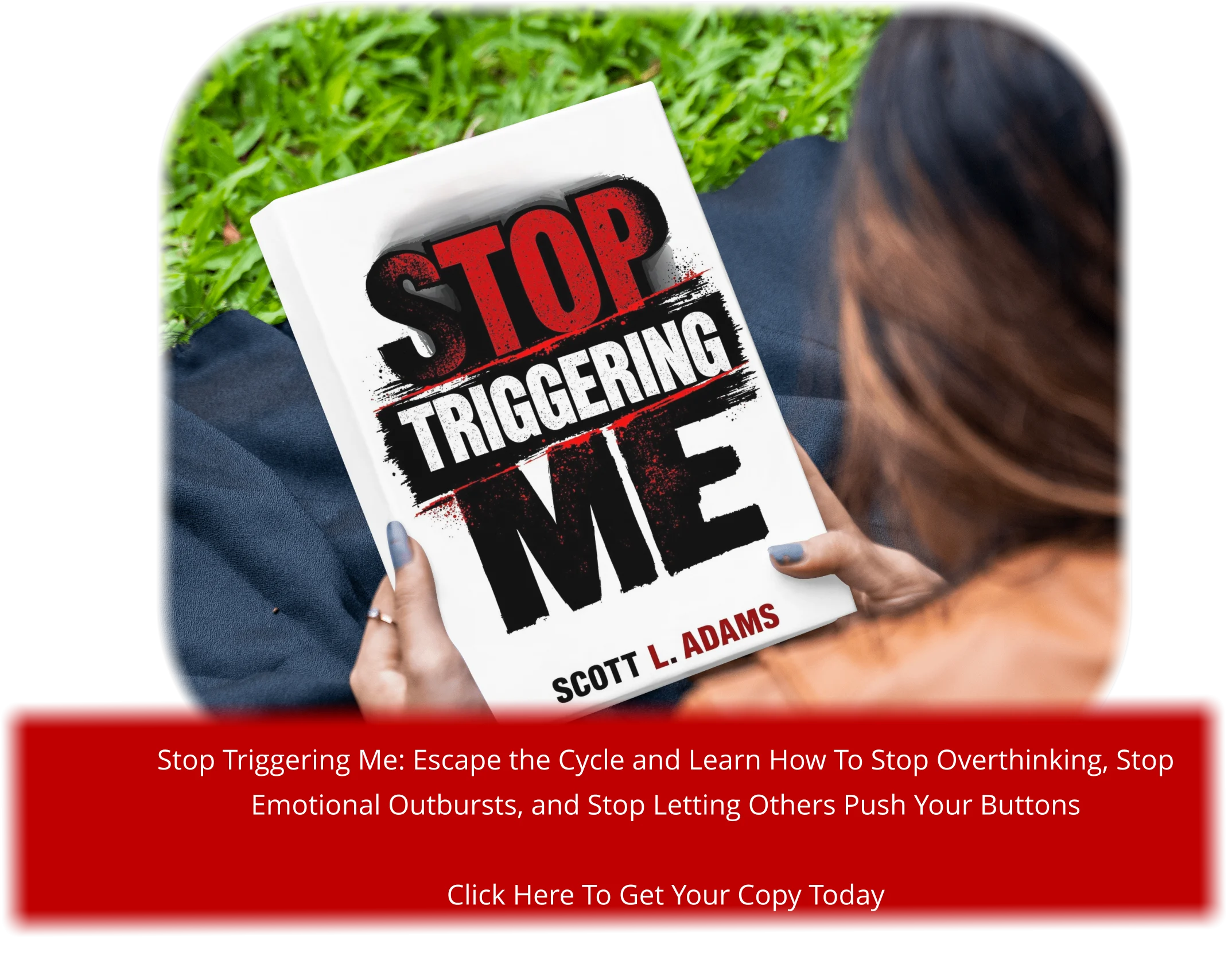Have you ever found yourself lying in bed, replaying a conversation from earlier in the day? I know I have. It’s like my mind becomes a broken record, looping the same thought over and over. This habit of overthinking can feel overwhelming, and it’s something many of us struggle with.
For me, it started with small things—a comment I made at work or a text I sent to a friend. But soon, these racing thoughts began to take over, making it hard to focus or even sleep. I realized I needed to find a way to break free from this cycle.
Overthinking isn’t just annoying; it can seriously impact your mental health. Studies show that 40% of adults experience racing thoughts at some point, often triggered by stress or anxiety1. The good news? There are proven techniques to help calm your mind and regain control.
In this guide, I’ll share the steps I took to stop replaying conversations in my head. From deep breathing to mindfulness, these strategies have made a world of difference for me. Let’s explore how you can find relief too.
Key Takeaways
- Overthinking can trap you in a cycle of replaying conversations.
- Racing thoughts are common, affecting 40% of adults1.
- Stress and anxiety are major triggers for overthinking.
- Techniques like deep breathing and mindfulness can help.
- Professional guidance is available for those who need it.
Understanding Overthinking and Racing Thoughts
Do you find it hard to quiet your mind, even when you’re trying to relax? This is a common experience for many people, especially those dealing with overthinking. It’s like your brain is on autopilot, replaying the same ideas or scenarios repeatedly. This can make it tough to focus, sleep, or even enjoy the present moment.
What Are Racing Thoughts?
Racing thoughts are rapid, repetitive sequences of ideas that feel out of control. They can be triggered by stress, anxiety, or even certain mental health conditions. For example, they are often linked to bipolar disorder, particularly during manic episodes2. These thoughts can disrupt concentration and make it hard to relax or sleep.
I’ve personally experienced how overwhelming this can be. One moment, I’m trying to focus on a task, and the next, my mind is flooded with unrelated ideas. It’s exhausting and can leave you feeling drained.
How Overthinking Impacts Daily Life
Overthinking doesn’t just affect your mental health; it can interfere with your daily life. For instance, it can make decision-making harder, as you constantly second-guess yourself. It can also strain relationships, as you might overanalyze conversations or interactions.
Research shows that racing thoughts are a symptom of several mental health conditions, including anxiety and OCD3. These conditions can significantly impact a person’s quality of life, making it essential to address the root cause. If you’ve been experiencing these symptoms for more than two weeks, it might be time to seek professional help.
Understanding overthinking and its effects is the first step toward finding relief. By recognizing the patterns, you can start to take control and implement strategies to calm your mind.
Identifying the Causes of Racing Thoughts
Ever felt like your mind is on a treadmill, running endlessly without pause? This feeling often stems from underlying causes that need to be addressed. Understanding these triggers is the first step toward finding relief.
Anxiety, OCD, and Other Mental Health Challenges
Anxiety is one of the most common culprits behind a restless mind. During an anxiety episode, your brain can feel like it’s stuck in overdrive. This is especially true for those with obsessive-compulsive disorder (OCD), where repetitive ideas can dominate your thinking4.
Conditions like bipolar disorder also play a role. During manic episodes, the mind races uncontrollably, making it hard to focus or relax5. If you’ve experienced this, know you’re not alone—and help is available.
The Role of Stress and Medication Side Effects
Stress is another major trigger. It can turn even small worries into overwhelming mental noise. For example, research shows that eliminating stress for at least two hours before bed can significantly reduce these symptoms4.
Medications, while helpful, can sometimes make things worse. Certain drugs for anxiety or bipolar disorder may increase mental restlessness as a side effect5. If you suspect this is happening, talk to your doctor about adjusting your treatment plan.
“Understanding the root cause of your mental restlessness is the first step toward finding peace.”
Here are some strategies to identify the underlying issue:
- Track your symptoms to spot patterns.
- Consult a mental health professional for an accurate diagnosis.
- Review your medications with your doctor to rule out side effects.
If these symptoms persist, don’t hesitate to seek help. Early intervention can make a world of difference in managing these challenges5.
Practical Techniques to Stop Your Mind from Racing
Have you ever felt your mind spiraling out of control, unable to stop the endless chatter? I’ve been there, and I know how exhausting it can be. The good news is, there are simple yet effective techniques to help you regain control and find peace.
Utilizing Mantras for Calming the Mind
One of the most powerful tools I’ve found is repeating a calming mantra. Phrases like “Everything will be fine” or “I am in control” can help shift your focus away from worry. Studies show that engaging in gratitude right before bedtime results in a calmer body and more positive pre-sleep thoughts6.
Here’s how I use mantras:
- Choose a phrase that resonates with you.
- Repeat it silently or aloud when you feel overwhelmed.
- Pair it with deep breaths for added calm.
This simple technique can make a big difference over time.
Breaking the Cycle of Catastrophic Thinking
Another challenge I faced was catastrophic thinking—imagining the worst-case scenario. To break this cycle, I started reframing my thoughts. Instead of focusing on what might go wrong, I shifted my attention to what I could control.
For example, research shows that dedicating 15 minutes to logging worrisome ideas can reduce anxious thinking6. Here’s what works for me:
- Write down your worries to get them out of your head.
- Challenge each worry with a more balanced perspective.
- Focus on solutions rather than problems.
These cognitive strategies can help you manage stress and anxiety more effectively.
“Small changes in your thinking patterns can lead to significant relief over time.”
Consistency is key. Whether it’s practicing mantras or reframing negative ideas, dedicating time to these methods can gradually reduce the intensity of your mental restlessness. Start small, and you’ll see progress.
Deep Breathing, Meditation, and Mindfulness
Have you ever tried to quiet your mind but found it harder than expected? I’ve been there, and I know how frustrating it can be. The good news is, simple practices like deep breathing, meditation, and mindfulness can help you regain control and find peace.
These techniques are more than just trendy buzzwords—they’re proven tools to calm your nervous system and reduce stress. Studies show that deep breathing during yoga or meditation can significantly lower anxiety7. Mindfulness practices have also been found to alleviate symptoms of depression and chronic pain8.
Step-by-Step Breathing Techniques
One of the most effective ways to calm your mind is through structured breathing exercises. Here’s how I use them:
- 4-7-8 Breathing: Inhale for 4 seconds, hold for 7 seconds, and exhale for 8 seconds. Repeat this cycle 4-5 times to feel immediate relief9.
- Box Breathing: Inhale for 4 seconds, hold for 4 seconds, exhale for 4 seconds, and hold again for 4 seconds. This technique is great for improving focus and reducing stress.
- Diaphragmatic Breathing: Focus on breathing deeply into your diaphragm rather than shallow chest breaths. This helps activate your body’s relaxation response.
These methods are simple, but they can make a big difference over time. I’ve found that even a minute of deep breathing can reset my mood and clear my mind.
“Breathing is the bridge between the mind and body. When you control your breath, you control your thoughts.”
Mindfulness is another powerful tool. It’s about staying present and focusing on the here and now. For me, this means paying attention to each breath—feeling the air enter and leave my body. Research shows that mindfulness can lower symptoms of depression and anxiety, making it a valuable practice for mental health8.
Here are some tips to get started with mindfulness:
- Set aside 5-10 minutes daily in a quiet space.
- Focus on your breath or a specific sensation, like the feeling of your feet on the ground.
- If your mind wanders, gently bring it back to your focus point.
Consistency is key. Whether it’s deep breathing or mindfulness, dedicating time to these practices can gradually reduce mental restlessness. Start small, and you’ll see progress.
Incorporating Exercise and Lifestyle Adjustments
Have you ever felt stuck in a loop of worry, unable to break free? I’ve been there, and I know how overwhelming it can be. The good news is, simple changes like regular exercise and a calming bedtime routine can make a world of difference. These adjustments not only improve your physical health but also boost your mental well-being.
How Physical Activity Improves Mental Health
When I started incorporating exercise into my daily routine, I noticed a significant shift in my mood and clarity. Studies show that just 30 minutes of moderate-intensity exercise can increase resilience to stress10. Whether it’s a brisk walk or a yoga session, physical activity helps regulate dopamine levels, which is crucial for managing conditions like ADHD11.
Here’s what worked for me:
- Start small—even 10 minutes of movement can make a difference.
- Choose activities you enjoy, like dancing or cycling.
- Set a consistent schedule to build a habit.
Regular exercise has been shown to reduce symptoms of depression and anxiety, making it a powerful treatment option12. It’s not just about fitness; it’s about creating a healthier mind.
Establishing a Relaxing Bedtime Routine
Overthinking often peaks at night, making it hard to unwind. I found that a calming bedtime routine helped me break this cycle. Research shows that a consistent pre-sleep ritual can improve sleep quality and reduce stress10.
Here’s how I created my routine:
- Turn off screens at least an hour before bed.
- Practice deep breathing or meditation to calm the mind.
- Keep a journal to jot down worries and let them go.
These small changes not only improved my sleep but also enhanced my overall mental well-being. A good night’s rest is a key part of any treatment plan11.
“Taking care of your body is the first step toward taking care of your mind.”
Incorporating exercise and lifestyle adjustments doesn’t have to be overwhelming. Start with one change, and gradually build from there. Over time, these habits can transform your mental health and help you break free from the cycle of worry.
Therapy and Professional Treatment Options
When I first considered therapy, I wasn’t sure it would help, but it turned out to be a game-changer. Seeking professional guidance was one of the best decisions I made for my mental health. It gave me tools to break free from the pattern of overthinking and regain control of my life.
Cognitive Behavioral Therapy (CBT) Approaches
CBT has been a cornerstone in my journey. This structured, goal-oriented therapy helps you understand how your thoughts influence your actions. By identifying negative patterns, you can replace them with healthier ones. For example, CBT is highly effective in treating intrusive ideas and obsessive-compulsive disorder13.
Here’s how CBT worked for me:
- I learned to challenge my negative feelings and reframe them.
- My therapist helped me develop coping strategies for stress and anxiety.
- Over time, I noticed a significant improvement in my overall life quality.
Medication and Professional Guidance
For some, medication is a necessary part of treatment. Medications like selective serotonin reuptake inhibitors (SSRIs) can help stabilize mood and reduce disruptive patterns. However, they may take about 10 weeks to show results and can have side effects like headaches or difficulty sleeping13.
Here’s what I learned about medication:
- It’s essential to work with a professional to find the right treatment plan.
- Medications like Prozac and Zoloft are commonly prescribed for conditions like hyperactivity disorder and anxiety13.
- Combining medication with therapy often yields the best results.
“Therapy isn’t about fixing what’s broken; it’s about understanding what’s working and building on it.”
If you’re struggling with overthinking or other mental health challenges, reaching out to a professional can be a life-changing step. Whether it’s through CBT, medication, or a combination of both, there’s hope for a calmer, more balanced life.
Managing Racing thoughts: Self-Care and Coping Strategies
Do you ever feel like your mind is cluttered with endless worries? I’ve been there, and I know how overwhelming it can be. The good news is, small daily habits can make a big difference in reducing mental clutter and calming your mind.
One of the most effective strategies I’ve found is journaling. Writing down my worries helps me process them and let them go. Studies show that expressive writing can significantly reduce anxiety over time14. It’s a simple practice that can bring clarity and peace.
Daily Habits to Reduce Mental Clutter
Creating a structured routine has been a game-changer for me. Here’s what works:
- Schedule Worry Time: Set aside 10-15 minutes daily to focus on your concerns. This helps contain them to a specific time, reducing their impact on the rest of your day15.
- Engage in Hobbies: Activities like painting, gardening, or playing music can distract your mind and provide a sense of accomplishment.
- Practice Mindfulness: Spend a few minutes each day focusing on your breath or surroundings. This can help ground you and reduce mental noise.
These habits don’t just reduce clutter—they build resilience against stress and anxiety. Over time, they become second nature, helping you manage your thoughts more effectively.
“Small, consistent steps can lead to big changes in your mental well-being.”
Another helpful practice is setting boundaries with your thoughts. For example, if you notice yourself spiraling into catastrophic thinking, gently redirect your focus. Research shows that acceptance of uncontrollable worries can reduce stress-related symptoms by 40%15.
Here’s how I apply this:
- Acknowledge the worry without judgment.
- Ask yourself if it’s something you can control right now.
- If not, let it go and focus on the present moment.
Experiment with these strategies to find what resonates with you. Whether it’s journaling, hobbies, or mindfulness, consistency is key. Over time, these small steps can transform your mental health and help you break free from the cycle of worry.
Quick Coping Strategies for Immediate Relief
Have you ever felt like your mind is a whirlwind of worries, impossible to calm? I’ve been there, and I know how overwhelming it can be. The good news is, there are simple strategies to help you find relief in the moment. These techniques can interrupt the cause racing thoughts and bring you back to the present16.
Distraction Techniques and Hobbies
One of the most effective ways I’ve found to calm my mind is through distraction. Switching your focus to a favorite hobby or creative task can provide instant relief. For example, I often turn to painting or listening to music when I feel overwhelmed. Studies show that engaging in creative activities can reduce anxiety by up to 40%17.
Here are some distraction techniques that work for me:
- Listen to Music: Create a playlist of calming or upbeat songs to shift your mood.
- Take a Walk: A brief walk outdoors can help clear your mind and reduce stress.
- Engage in a Hobby: Whether it’s knitting, gardening, or cooking, focus on something you enjoy.
“Distraction isn’t about avoiding problems; it’s about giving your mind a break to reset.”
Another helpful strategy is the 5-4-3-2-1 grounding technique. This involves identifying five things you see, four you can touch, three you hear, two you smell, and one you taste. It’s a simple way to refocus your attention and reduce anxiety16.
Recognizing the early symptom of a racing mind is key. Acting quickly can prevent the spiral from worsening. These tactics are temporary but effective until longer-term strategies take effect. If you’re struggling, don’t hesitate to reach out to a mental health professional for support17.
Conclusion
Breaking free from the cycle of overthinking isn’t easy, but it’s possible with the right tools. Throughout this article, we’ve explored practical strategies like mindfulness, exercise, and lifestyle adjustments to calm a busy mind. These methods, combined with therapy, can make a significant difference in managing mental restlessness18.
Remember, recovery takes time and consistent effort. If you’re struggling, know that you’re not alone. Seeking professional help is a powerful step toward regaining control. Studies show that therapy can reduce repetitive mental patterns by up to 50%19.
Start small—whether it’s deep breathing, journaling, or setting a calming bedtime routine. Over time, these habits can transform your mental health. You’ve got this, and support is always available.







